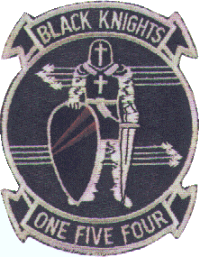
Posted on 04/02/2003 6:05:30 AM PST by kattracks
Navy's F-14A Tomcat Crashes in Iraq
By ROHAN SULLIVAN .c The Associated Press
ABOARD THE USS KITTY HAWK (AP) - A F-14 Tomcat strike fighter crashed into the Iraqi desert during a bombing mission early Wednesday after a mechanical failure caused its engines to fail, senior Navy officers said.
The pilot and a second crewman ejected to safety and were rescued by helicopter.
The F-14A - a type of plane that dates from the late 1960s and is among the Navy's oldest - went down in southern Iraq about 1:50 a.m. said Rear Adm. Matthew G. Moffit, commander of the aircraft carrier USS Kitty Hawk, the plane's base.
He declined to be more specific about the location.
The two crew on board - the fighter's pilot and its radio intercept officer - ejected from the cockpit and parachuted to the ground, he said.
A search and rescue helicopter reached the downed crew ``fairly rapidly'' and they were taken to Ahmed Al Jaber Air base in Kuwait for medical checkups.
Capt. Patrick Driscoll, the commander of the Kitty Hawk's air wing, said the radio intercept officer injured his ankle and that both crew received minor injuries from the ejection and landing.
The crash was the first confirmed report of a U.S. plane going down in Iraq during the war, but was the third Navy plane to be lost to accidents or mechanical problems in the Persian Gulf within 24 hours.
A S-3B Viking plunged off the deck of the USS Constellation early Tuesday after a malfunction and an AV-8B Harrier jump jet went into the Gulf on Tuesday night while it was trying to land on the USS Nassau.
In both cases, pilots ejected from the planes and were rescued from the sea with minor injuries.
Moffit said the F-14 crash was the result of a mechanical failure, not enemy fire.
``The aircraft had a mechanical problem on the way to a mission,'' Moffit told reporters, adding that is apparently engine related.
The crash happened two hours after takeoff. The plane had dropped some bombs, but was carrying more when it crashed, he said.
Moffit said there was no enemy fire present and the plane ``was not in harms way or jeopardy'' at the time of the crash. The plane was from the Kitty Hawk's VF-154 squadron, which has been among Navy strike fighter groups that have flown hundreds of bombing missions over Iraq in the past two weeks.
Driscoll said the last crash of a plane in the air wing was at least five years ago.
The air campaign has intensified in recent days as Navy and Air Force warplanes pound Iraqi defenses in and around the capital of Baghdad ahead of an expected U.S. ground invasion.
Driscoll said the number of sorties being flown over Iraq had increased rapidly in recent days to support the movement of the 1st Marine Expeditionary Force and the Army's V Corps, which are both just south of Baghdad.
Kitty Hawk-based planes have also bombed targets further south, in Basra.
Moffit said the pace of current operations was probably not a factor in the crash, although stress or fatigue on the pilots or the aircraft would be part of the investigation.
He said carrier-based planes and crew could operate safely at a high level of intensity. Three U.S. aircraft carriers are in northern Gulf waters taking part in the war in Iraq.
The F-14A is a twin-engine, supersonic sweep-wing fighter that dates from the Vietnam era. It can carry a wide variety of laser-, satellite- and unguided bombs as well as air-to-air and air-to-ground missiles. While it is primarily a strike plane, its two-person crew gives it extra communications and target-locating capability compared to the newer F/A-18 Hornets. The Navy's Tomcats are being phased out and replaced with the F/A-18E and F/A-18F Super Hornet.
Moffit warned against complacency among pilots and air crews that launch fighters from carriers, and the ordnance crews that load them with bombs.
``We have a tendency to lose more aircraft to mechanical and normal operating events than we do to combat,'' Moffit noted. ``Complacency is out biggest enemy.''
04/02/03 08:59 EST

Disclaimer: Opinions posted on Free Republic are those of the individual posters and do not necessarily represent the opinion of Free Republic or its management. All materials posted herein are protected by copyright law and the exemption for fair use of copyrighted works.